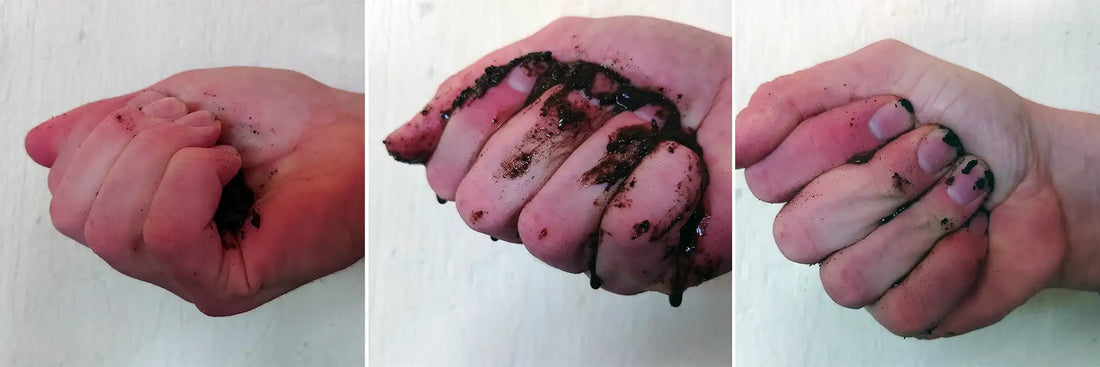Moisture is one of the most crucial factors in worm composting. The moisture content is influenced by the surrounding climate and the waste added. The compost should always be pleasantly moist, but not too wet—like a squeezed sponge.
How moist should the compost be?
Earthworms need sufficient moisture to breathe through their skin. Therefore, the worm composter should have a moisture content of 60 to 85% in the top 10-15 cm, where the activity of the compost worms is greatest. Deeper layers can be gradually drier.
Regularly observe if the surface looks moist and the worms have shiny skin. You can also test the moisture content using the squeeze test. Take a handful of worm compost and squeeze it:
- Too dry: If no water comes out or the compost crumbles when opening your hand, it's too dry.
- Too wet: If a lot of water drips from your fist, it's too wet.
- Optimal: If some water seeps between your fingers but hardly drips to the ground, the moisture is right. Upon opening your fist, the material should retain its shape.

Correct moisture: Little water escapes between the fingers. The compost retains its shape when opened.
Signs of Too Much Moisture
- Unpleasant Smell: An unpleasant smell in the composter usually indicates something is wrong, often pointing to a lack of oxygen in the system, caused by a lack of structural material and too much water.
- Frequent Appearance of Unwanted Guests: In addition to smell issues, pests like fungus gnats or shore flies may proliferate, thriving in excessively moist conditions.
- Strong Discolorations on the Worm Composter: Efflorescences are characteristic of porous clay vessels. However, strong discolorations or even leaking liquid are signs of a substrate that's too wet.

Too Wet: A lot of water drips from the hand, the compost is mushy.
Measures if the Compost is Too Moist
- Add Structural Material: Incorporate dry structural material and temporarily reduce the amount of feed.
- Add Soil: Mix in outdoor soil or old potting soil into the composter. Soil absorbs moisture, improves structure, and contains valuable minerals. Avoid forest soil to prevent introducing unwanted pests. Do not take soil during or immediately after heavy rain to ensure it's not too wet.
- Include Cardboard: Add cardboard only if the compost is slightly too moist. Although dry cardboard effectively absorbs moisture, it's not the optimal structural material. Use it sparingly to avoid making the compost mushy and restricting air circulation. Corrugated cardboard provides slightly better structure compared to egg cartons.
5 Materials for Moisture Reduction
- Cardboard and egg cartons
- Soil
- Minerals like rock dust, crushed eggshells, or our Mineral Mix
- Bedding
- Straw or dried leaves
Signs that the composter is too dry
- Lethargic Worms: If worms become sluggish and seek out moister areas, this indicates an environment that's too dry. They need moisture to survive and compost efficiently.
- Dusty Compost: Dry, easily crumbling compost indicates insufficient moisture. The compost should be moist and crumbly, not dusty.
- Slowed Decomposition: Low microbial activity due to dryness leads to delayed composting. Microorganisms, like worms, require a moist environment to break down organic materials.

Too dry: No water is recognisable, the compost crumbles apart.
Measures if the Compost is Too Dry
- Moisten the Compost: Gradually moisten the compost in small amounts with a spray bottle to avoid drowning the composter. Too much water leads to a lack of oxygen and causes rot, usually problematic in home composters.
- Add Moist Waste: Incorporate moist kitchen scraps like fruit and vegetable remnants to increase the compost's moisture. Ensure a balanced structure in the compost to prevent compaction.
- Cover the Composter: To better retain moisture, it might be helpful to cover the surface of the composter. This is especially advisable for larger or standalone composters. Materials like cardboard, fleece, or hemp mats are suitable to minimize evaporation while allowing good air circulation. A layer of mulching material like straw, leaves, or moist cardboard on the compost's surface can also help.
5 materials to increase moisture
- Fruit and vegetable scraps
- Cardboard soaked in water
- Coffee grounds
- Tea bags
- Fresh plant residues
Tips for the right moisture level
- Adjust moisture before feeding: Check the appropriate moisture of the starting materials before feeding. If the wastes are too dry, you can briefly soak them in water. If they're too wet, add more structural material or soil to the feed mix.
- Ensure a balanced material mix: A good mix of nitrogen-rich "green" and carbon-rich "brown" material often coincides with a good moisture content. Green wastes like fruit and vegetables contribute to the moisture with their natural water content, while brown materials like wood pieces, root remnants, or nutshells provide structure and regulate moisture. For detailed information on the optimal mixing ratio and the C/N ratio, see our blog "The C/N Ratio in Practice."

Choosing the Right Composter
Materials and their importance for moisture regulation
The material of the worm composter greatly affects moisture regulation and the composting process. In plastic containers, ensuring the compost isn't too moist can be challenging. Water often accumulates at the bottom, leading to oxygen deficiency and rot. Most plastic models feature a drainage tap to remove excess water.
Worm composters made from breathable clay offer natural advantages for effective moisture regulation. They maintain optimal moisture levels and create a natural habitat for the worms. The porous clay allows for the even evaporation of excess water, preventing leaching and preserving valuable nutrients in the worm humus. Thanks to the natural regulatory properties of clay, an additional drain or tap is often unnecessary.
Wood composters also provide a natural and breathable solution for moisture control. They absorb and release excess moisture, creating a favorable microclimate for decomposition. Wood also moderates temperature fluctuations, ideal for colder climates. However, wood is susceptible to rot, which can shorten its lifespan compared to plastic or clay composters. The choice of wood is crucial: larch wood is known for its durability, while spruce wood is more prone to quick decomposition. Additionally, it's important to ensure the wood is untreated to prevent contaminants in the compost.
Moisture throughout the year and during relocation
Changes in the environment and season affect moisture needs. In heated rooms during winter or dry periods, adjusting water supply might be necessary. The same applies when moving the composter from indoors to outdoors or vice versa. Initially reduce the amount of material added and observe the worms' reaction and the rate of decomposition.

